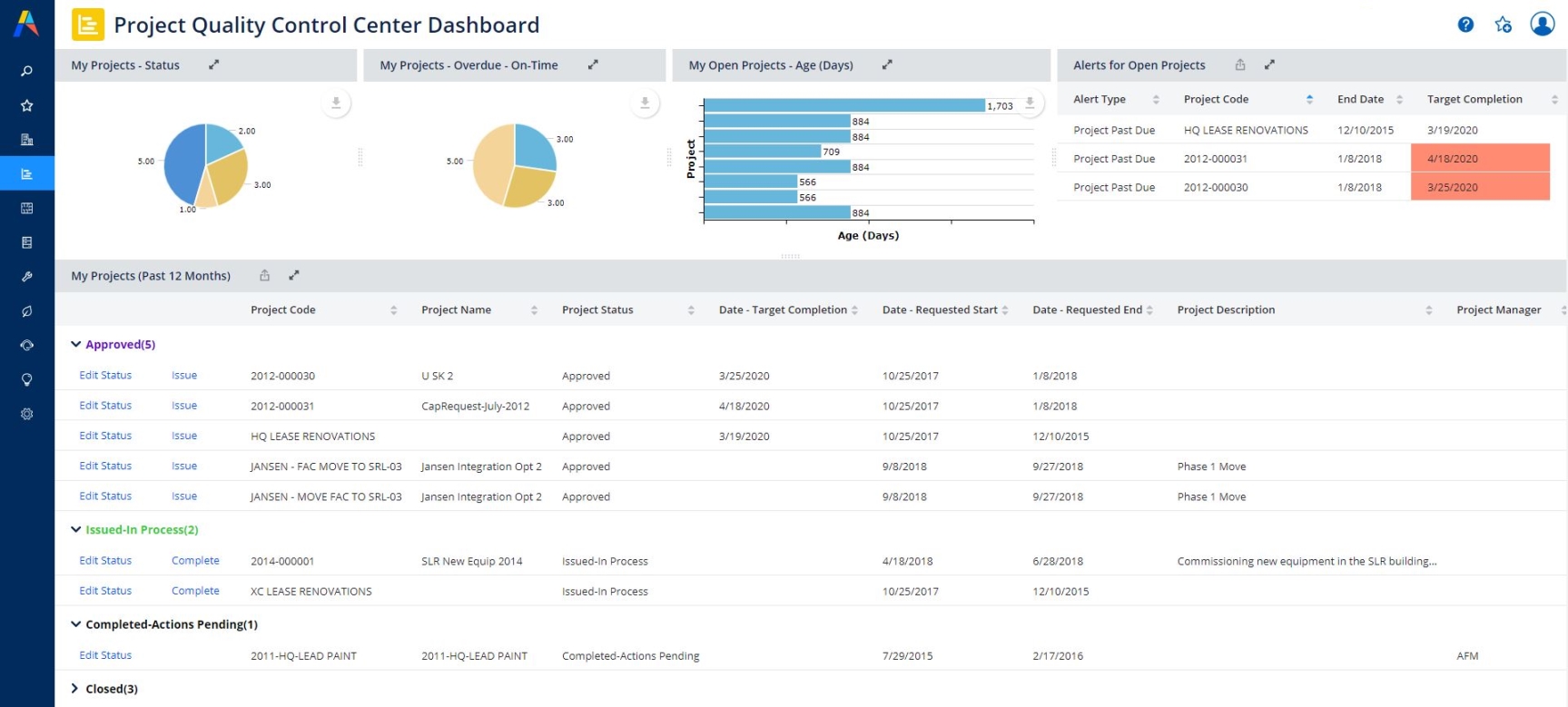Getting Results with Archibus
Projects
The Archibus Projects application focuses on the details of planning and executing the individual capital projects (which can be defined with the Capital Budgeting application).
The prioritization of improvements such as roof repairs, land purchases, elevator replacements, hazardous material removal, and HVAC upgrades must be carefully analyzed, and once approved, these projects need to be quickly and efficiently executed to minimize disruption to the working environment and to support scheduled business initiatives.
With the Projects application, all parties involved in a capital project—from the requestor, to the approving managers, to the vendors bidding on the work, to the craftspersons executing the work, to the project managers tracking cost variances—can work collaboratively over the Web to ensure that the project is completed on time and within budget.
The application covers the entire project management process, including:
- Planning
- Budgeting
- Project Design
- Bidding
- Execution
- Management and Oversight Reporting
- Historical and Trend Reporting

|
Projects |
|
|---|---|
|
Location |
This is available in both Archibus SaaS and the Archibus non-SaaS offering.
|
|
Business Result |
Capital projects that are completed on-time and within budget using a collaborative working method. Overall improved efficiency, cost control, communication, and execution of capital projects. |
|
Used By |
Project Requestors Facility Managers Project Managers Executives Craftspersons Vendors Architects Engineers |
|
Reasons for Automating |
Provide a collaborative working method for all users (including internal staff and external vendors and craftspersons) to work with all phases of capital projects. Provide a central repository and tracking system for project documentation which key stakeholders can access over the Web or a corporate Intranet. Manage change orders to the initial project and assess impact on schedule and budget. Use the system's automatic workflow to ensure that the team members and vendors receive email notifications so that the project can progress efficiently towards completion. |
|
Prerequisite Applications |
The Capital Budgeting application can identify the necessary capital improvements that need to be managed with projects. You can create projects in several applications, such as Hazard Abatement and Space Planning, and then use Projects to manage these projects through the various stages. |
|
Results/Reports |
Several management consoles are available. Important reports include: Commitment Status Progress Report Work-In-Place Projections Project Scorecard Project Status Projects Behind Schedule/Over Budget Project Milestone Statuses Project Analysis Project Metrics Costs by Project Vendor Performance History Invoices and Payments Schedule Variances Change Orders Work Packages out for Bid Approved Project Funding by Year Estimated Baseline Costs |
The following are typical users:
|
User |
Tasks |
|---|---|
|
Requestors |
Anyone can request a capital project by completing the Request Project form. |
|
Facility Managers |
Work with a project from its requested to approved state. They typically:
|
|
Project Managers |
Detail the project and monitors the day-to-day details of the project execution. The project manager is the major user of the Projects application and performs such tasks as:
|
|
Architects and Engineers |
Provide their expertise to the planning and execution of the capital project and any changes that arise. Typically use tasks in the Plan, Execute, and Monitor processes to address the architectural and engineering needs of the project. Architects and engineers may be responsible for developing CAD drawings of new space and detailed design plans. In the execution phase of the project, they may assist in resolving unforeseen problems, such as a measurement being off, or they may revise architectural plans if the exposure of a wall reveals pipes or other infrastructure that they did not expect. |
|
Vendors |
Log on to the Web and have direct access to the current status of the capital project so that they can check the work available for bid and submit a bid over the Web. |
|
Craftspersons |
Can directly enter their notes into the project system by logging on to the Web and accessing tasks specific to their needs and assigned project. For example, they may need to do the following:
|
|
Executives |
Access several oversight and management reports that present summary data and provide drill-down tools to specific details. Use the many tasks of the Monitor process to access project scorecards, project metrics, and project analysis reports. |